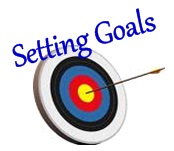Setting Goals
Your goals should be grown from your values, beliefs, desires, and your sense of purpose. Before you begin to create your goals, you should go through the process of self discovery.
Self-discovery is an exploration through your inner self, trying to discover who you are, your potential, and your purpose in life. Self-discovery will help you determine what you really want out of life and what will give you a personal sense of fulfilment.
Types of Goals
There are different types of goals. Some goals are lifetime goals; meaning that you intend to achieve them before you die. To achieve them, you break them into smaller goals, perhaps ten-year goals, five-year goals, and one-year goals.
These long-term and intermediate goals are then divided into smaller segments, until you have subdivided the lifetime goals into immediate and short-term goals. You eventually break goals down into tasks and objectives that you can work on a daily basis.
You may also set long-term and short-term goals for yourself that are not tied to lifetime goals. For example, you may have a long-term goal of purchasing a car or a short-term goal of losing 25 pounds.
Long-term goals – typically takes longer than a year to achieve
Short-term goals – typically takes less than one year to achieve
Setting Personal Goals
Setting personal goals starts with your Lifetime goals which are followed by a series of lower level goals. The series of goals and objectives can continue until you have a list of daily tasks.
By setting up this structure, you are able to break down lifetime goals into a number of small tasks that you need to do each day to reach your ultimate goals.
Setting Your Lifetime Goals
You set lifetime goals by envisioning what you ultimately want to achieve in various facets of your life. These facets may include the following:
- Career
- Education
- Financial
- Family / Relationships
- Physical Health
- Travel
- Spiritual / Emotional
- Travel and Adventure
After you determine your lifetime goal, you then set additional long-term goals for by determining what you want to be doing and where they want to be five to ten years from the present. Then you use short-term goals to get there.
Steps to Setting Goals
- After you determine what you want to accomplish for the various aspects of your life, write down your lifetime goals.
- After you have your lifetime goals written, lay out your plan of actions that will determine how to you reach them.
- Set additional long-term goals that will help you reach your lifetime goals. For example, if you have a lifetime goal of becoming an Engineer, you would need long-term educational goals for a specific college degree.
- Once you have set your long-term goals, set up your short-term goals that you should complete if you are to reach your lifetime plan. For example, a short-term goal tied to your long-term goal of becoming an Engineer, may be to get an “A” on specific school course.
- You can set a 5-year plan, 1-year plan, 6-month plan, and 1-month plan of progressively smaller goals that you should reach to achieve your lifetime goals. Each of these should be based on the previous plan.
- Finally, set a daily “to do” list of things that you should do today to work towards your goals.
“If not us, who? If not now, when?” Kennedy, John F.
Goal Setting Overview



